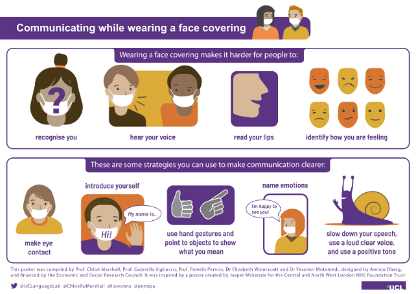On the advice of the UK government, more and more people are wearing face coverings in order to reduce COVID-19 transmission. However, face coverings muffle the sounds of speech, and – if they are opaque, as the vast majority are – they make it impossible to read the wearer’s lips. They also make emotional expressions on the face harder to identify. Face coverings therefore reduce the auditory and visual cues that are necessary for successful spoken language communication.
The likely impact on communication in noisy environments, for people who are not proficient English speakers, and for people who are deaf and hard of hearing is obvious. A further group likely to be impacted are children, whose language system is not yet fully developed and who are still on their way to gaining the sophisticated language knowledge that can be used to ‘fill in the blanks’ when something is not heard or understood.
CEN member Prof. Chloë Marshall and her colleagues at UCL and the University of Cologne have a particular interest in the multimodality of communication, and they are studying how multimodal cues support young children’s spoken language learning*. When we speak we don’t just produce speech sounds, we communicate in other ways, too. We use our hands to point, to gesture the forms of the things we are talking about, and to add emphasis to something important. We use eye gaze to direct the attention of the person or people we are communicating with and to regulate conversational turn-taking. We modulate the pitch, tone and speed of our voice to emphasise certain meanings, and we use sound effects and onomatopeia.
Chloë and her colleagues’ research is demonstrating that these cues play an important role in supporting children’s language development and that they contribute to making communication with children successful. And yet, many parents, caregivers and teachers are unaware that they have this rich set of multimodal resources at their disposal.
In order to help adults who communicate regularly with children to think about how to make their communication clearer while wearing a face covering, Chloë and her colleagues have produced a poster. The poster outlines some of the communicative challenges of wearing a face covering and some of the ways in which those challenges can be overcome using multimodal communication. It is free to download here and can be distributed electronically or printed out. Please do use it if you think it will be helpful!
*Their project, titled The role of iconicity in word learning, is funded by the Economic and Social Research Council. You can watch a short video presentation of this project here.


